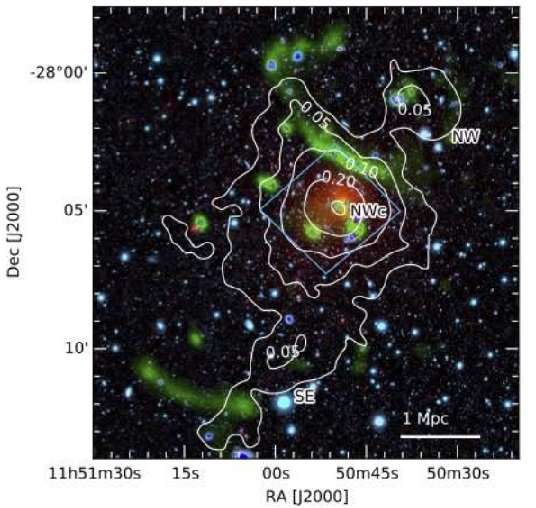Color-composite Subaru image with enhanced radio (green) and X-ray (red) emissions. Radio emissions are from GRMT observations (Bonafede et al. 2014) and X-ray emissions are from XMM-Newton. The overlaid convergence contours (white) peak in the X-ray emitting ICM with the highest contour enveloping the BCG. The mass is distributed along a direction similar to the axis connecting the radio relics. The HST F814W pointing is outlined in light blue. Image Credit: Finner et al., 2017.
New observations carried out by an international team of astronomers have provided important details about an extremely massive galaxy cluster named PLCK G287.0+32.9. The results of these observations, presented October 6 in a paper published on arXiv.org, reveal insights into the structure and mass distribution of this cluster.
PLCK G287.0+32.9 was detected by ESA's Planck telescope in 2011. First observations revealed that it is an extremely massive galaxy cluster at redshift of 0.39 with a mass of approximately 1.57 quadrillion solar masses. Subsequent studies of PLCK G287.0+32.9 found a pair of giant radio relics towards this cluster.
Radio relics are diffuse, elongated radio sources of synchrotron origin. They occur in the form of spectacular single or double symmetric arcs at the peripheries of galaxy clusters. These sources are believed to originate in acceleration and re-acceleration at merger shocks. Thus, in the case of PLCK G287.0+32.9, radio relics confirmed that it is a merging galaxy cluster.
However, the asymmetry of radio relics in PLCK G287.0+32.9 suggests a complex merging scenario. In order to investigate this assumption in detail, dark matter distribution in high resolution was required. Therefore, a team of astronomers led by Kyle Finner of the Yonsei University in Seoul, South Korea, has performed a weak-lensing analysis of the dark matter distribution of this cluster.
Finner and his colleagues employed the 8.2m Subaru Telescope in Hawaii and the Hubble Space Telescope (HST) for their observations. They observed PLCK G287.0+32.9 with the Subaru Telescope on February 26, 2014, and with HST on August 3, 2016 and on February 21, 2017.
"In this study, we present the first constraints on the mass distribution of PLCK G287.0+32.9 from a weak-lensing analysis of Subaru and HST observations. Our analysis with this new data set provides substantial improvements over the previous weak-lensing study of Gruen et al. (2014)," the paper reads.
Subaru and HST observations allowed the researchers to probe the mass distribution of the cluster and to discover its five substructures. PLCK G287.0+32.9 was found to be more massive than previously estimated, as the analysis indicates that it has a mass of approximately 2.04 quadrillion solar masses. The astronomers revealed that the mass of PLCK G287.0+32.9 is dominated by the primary cluster with three of the substructures being about 10 percent of the mass of the primary cluster, while the least massive fifth substructure cannot be considered a galaxy cluster.
"Our analysis shows that the mass distribution features four significant substructures that stretch in a northwest to south-east direction. Of the substructures, the primary cluster dominates the weak-lensing signal. This cluster is likely to be undergoing a merger with one (or more) subcluster whose mass is approximately a factor of 10 lower," the authors wrote in the paper.
The researchers hope that future deep HST imaging would provide more details about the substructures of PLCK G287.0+32.9.
More information: arxiv.org/pdf/1710.02527.pdf
© 2017 Phys.org
























